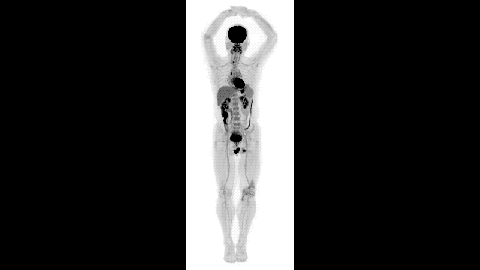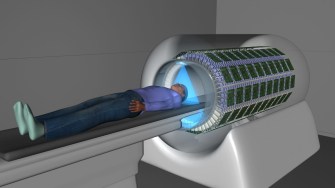New 3D body scanner uses 40 times less radiation than PET scans

(US Davis/Big Think)
- New medical imager captures unprecedented 3D images of the human body.
- It's 40 times faster than PET scans, and can use 40 times less radiation.
- EXPLORER scanner makes PET and CT scans look old-fashioned.
What do you get if you combine the technologies on which the two most successful medical imaging devices — positron emission tomography (PET) and x-ray computed tomography (CT) — are based? You get EXPLORER, the stunning new scanner that can capture an amazingly detailed 3D image of the entire human body in 20–30 seconds.
EXPLORER’s super-fast capture rate — it can scan a body region in about a second — also allows it to take movies of specially-tagged medications and radiotracers as they make their way through a body.

(UC Davis)
The development of EXPLORER
EXPLORER was developed at the UC Davis Department of Biomedical Engineering by biomedical engineers Simon Cherry and Ramsey Badawi in partnership with Shanghai-based United Imaging Healthcare (UIH). UIH plans eventually to manufacture and sell the devices worldwide.
Badawi and Cherry first conceived of something like EXPLORER some 13 years ago. In 2011, a $1.5 million grant from the National Cancer Institute allowed them to pull together a consortium of collaborators to work on the idea. The first working EXPLORER was made possible by a $15.5 million grant from the National Institutes of Health in 2015.
First look
The first images Badawi got his eyes on were captured by UIH and the Department of Nuclear Medicine at the Zhongshan Hospital in Shanghai, and they were eye-popping. As he told UC Davis Health:
The level of detail was astonishing, especially once we got the reconstruction method a bit more optimized. We could see features that you just don’t see on regular PET scans. . . And the dynamic sequence showing the radiotracer moving around the body in three dimensions over time was, frankly, mind-blowing. There is no other device that can obtain data like this in humans, so this is truly novel.

(UC Davis)
Benefits of EXPLORER
EXPLORER is 40 times as fast as a PET scanner, making it more feasible to do repeated studies on an individual, and, of course, there are the movies that can provide an unprecedented look at the in-body progress of radiotraceable agents. EXPLORER’S also 40 times more sensitive than PET scanners, so it will cause patients to be exposed to far less radiation during diagnosis than traditional PET or CT scans.
“The tradeoff between image quality, acquisition time and injected radiation dose will vary for different applications,” Cherry told UC Davis Health. “But in all cases, we can scan better, faster or with less radiation dose, or some combination of these.”
Doctors will also be able to see, for the first time, what’s happening simultaneously in multiple areas of the body, helping them measure dynamic processes such as bloodflow or glucose takeup. The uses for EXPLORER’s breakthrough technology seem endless.
The goal right now is to get the first working system up and running at the EXPLORER Imaging Center in Sacramento by June 2019. At that time, the scientists hope to begin using EXPLORER for research projects and for diagnosing patients. Meanwhile, at Zhongshan Hospital, investigation of EXPLORER’s potential continues.





